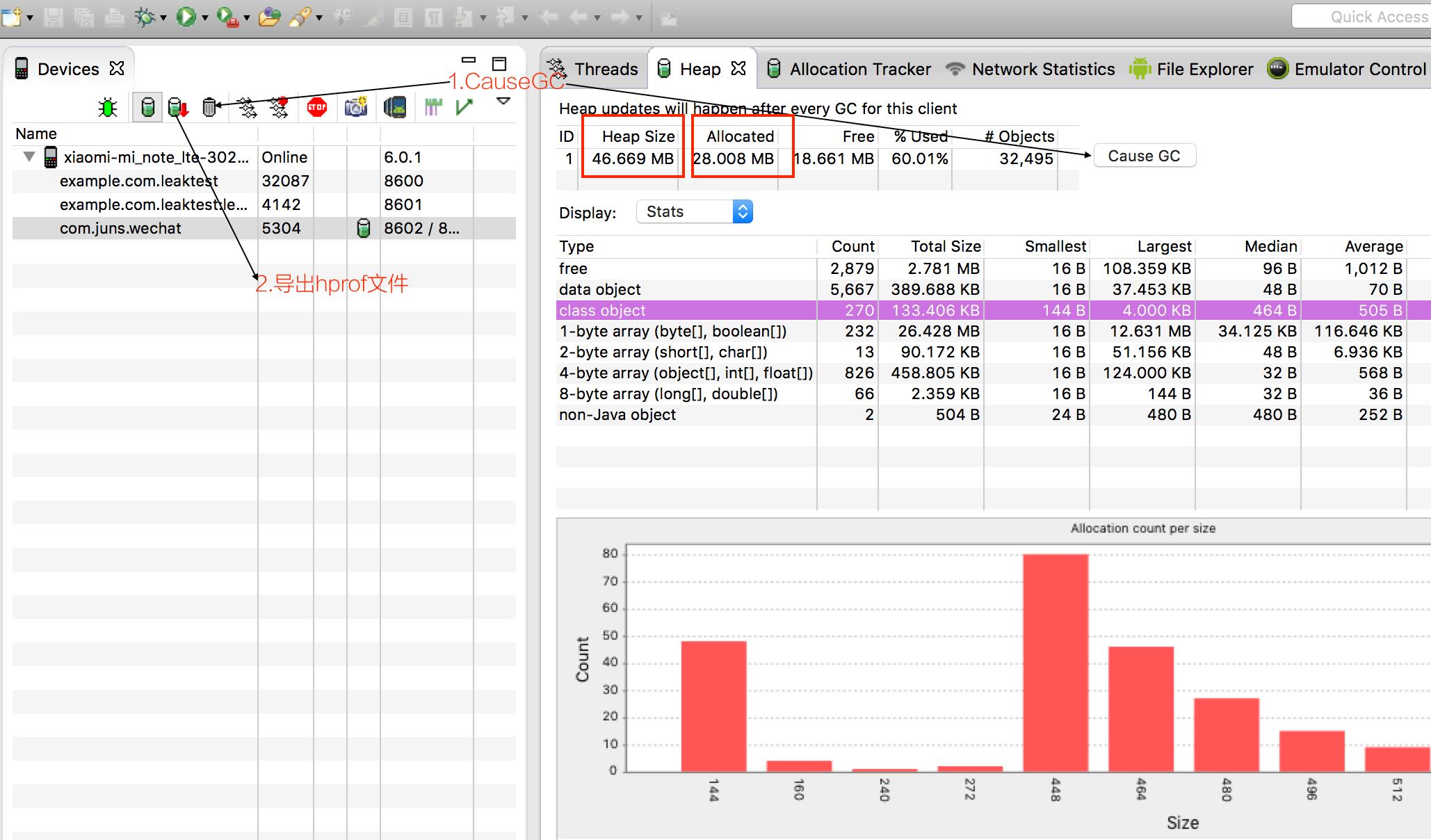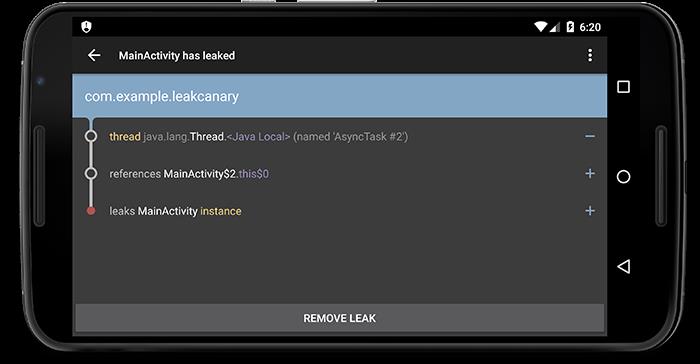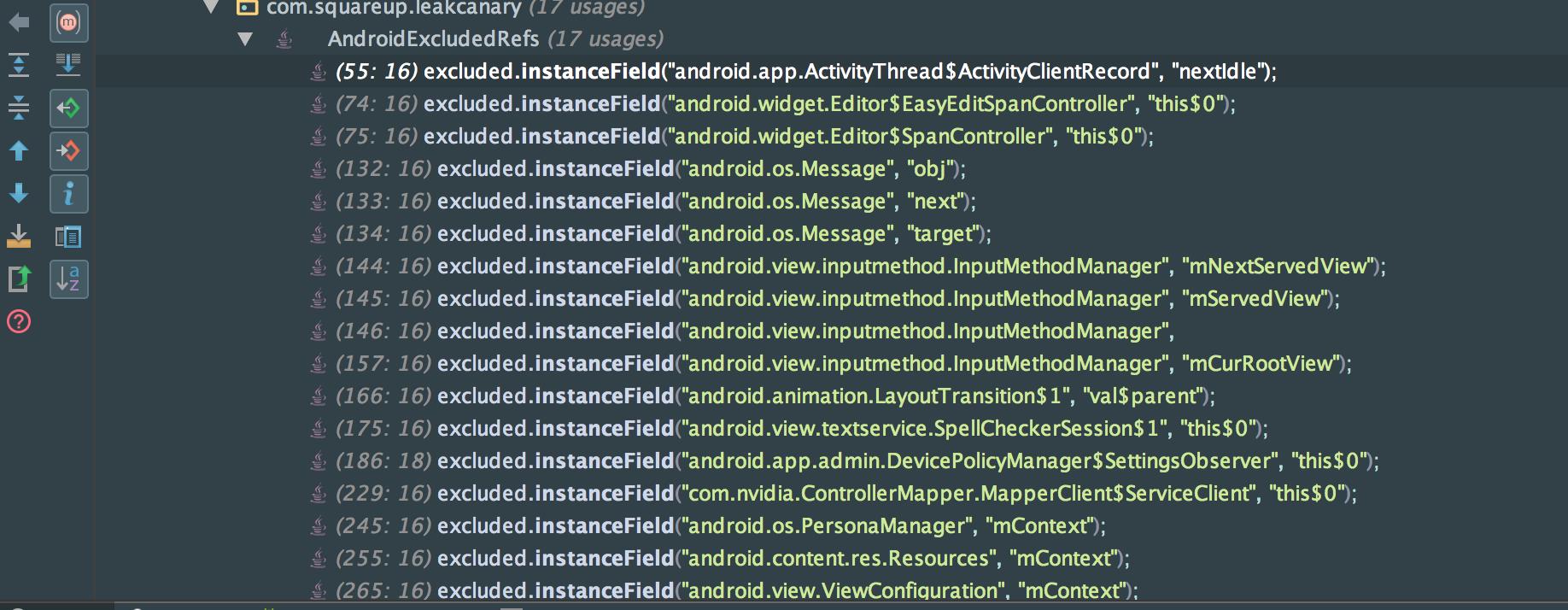Android内存泄露检测工具---LeakCanary的前世今生
Posted 逆水当行舟
tags:
篇首语:本文由小常识网(cha138.com)小编为大家整理,主要介绍了Android内存泄露检测工具---LeakCanary的前世今生相关的知识,希望对你有一定的参考价值。
原创地址:http://blog.csdn.net/zivensonice/article/details/51639763
曾经检测内存泄露的方式
让我们来看看在没有LeakCanary之前,我们怎么来检测内存泄露
1. Bug收集
通过Bugly、友盟这样的统计平台,统计Bug,了解OutOfMemaryError的情况。
2. 重现问题
对Bug进行筛选,归类,排除干扰项。然后为了重现问题,有时候你必须找到出现问题的机型,因为有些问题只会在特定的设备上才会出现。为了找到特定的机型,可能会想尽一切办法,去买、去借、去求人(14年的时候,上家公司专门派了一个商务去广州找了一家租赁手机的公司,借了50台手机回来,600块钱一天)。然后,为了重现问题,一遍一遍的尝试,去还原当时OutOfMemaryError出现的原因,用最原始、最粗暴的方式。
3. Dump导出hprof文件
使用Eclipse ADT的DDMS,观察Heap,然后点击手动GC按钮(Cause GC),观察内存增长情况,导出hprof文件。
主要观测的两项数据:
3-1. Heap Size的大小,当资源增加到堆空余空间不够的时候,系统会增加堆空间的大小,但是超过可分配的最大值(比如手机给App分配的最大堆空间为128M)就会发生OutOfMemaryError,这个时候进程就会被杀死。这个最大堆空间,不同手机会有不同的值,跟手机内存大小和厂商定制过后的系统存在关联。
3-2. Allocated堆中已分配的大小,这是应用程序实际占用的大小,资源回收后,这项数据会变小。
查看操作前后的堆数据,看是否存在内存泄露,比如反复打开、关闭一个页面,看看堆空间是否会一直增大。

4. 然后使用MAT内存分析工具打开,反复查看找到那些原本应该被回收掉的对象。
5. 计算这个对象到GC roots的最短强引用路径。
6. 确定那个路径中那个引用不该有,然后修复问题。
很麻烦,不是吗。现在有一个类库可以直接解决这个问题
LeakCanary
使用方式
使用androidStudio,在Module.app的build.gradle中引入
dependencies
debugCompile 'com.squareup.leakcanary:leakcanary-android:1.4-beta2'
releaseCompile 'com.squareup.leakcanary:leakcanary-android-no-op:1.4-beta2'
testCompile 'com.squareup.leakcanary:leakcanary-android-no-op:1.4-beta2'
然后在Application中重写onCreate()方法
public class ExampleApplication extends Application
@Override public void onCreate()
super.onCreate();
LeakCanary.install(this);
在Activity中写一些导致内存泄露的代码,当发生内存泄露了,会在通知栏弹出消息,点击跳转到泄露页面

LeakCanary 可以做到非常简单方便、低侵入性地捕获内存泄漏代码,甚至很多时候你可以捕捉到 Android 系统组件的内存泄漏代码,最关键是不用再进行(捕获错误+Bug归档+场景重现+Dump+Mat分析) 这一系列复杂操作,6得不行。
原理分析
如果我们自己实现
首先,设想如果让我们自己来实现一个LeakCanary,我们怎么来实现。
按照前面说的曾经检测内存的方式,我想,大概需要以下几个步骤:
1. 检测一个对象,查看他是否被回收了。
2. 如果没有被回收,使用DDMS的dump导出.hprof文件,确定是否内存泄露,如果泄露了导出最短引用路径
3. 把最短引用路径封装到一个对象中,用Intent发送给Notification,然后点击跳转到展示页,页面展示
检测对象,是否被回收
我们来看看,LeakCanary是不是按照这种方式实现的。除了刚才说的只需要在Application中的onCreate方法注册LeakCanary.install(this);这种方式。 查看源码,使用官方给的Demo示例代码中,我们发现有一个RefWatcher对象,也可以用来监测,看看它是如何使用的。
MainActivity.class
@Override
protected void onCreate(Bundle savedInstanceState)
super.onCreate(savedInstanceState);
setContentView(R.layout.activity_main);
RefWatcher refWatcher = LeakCanary.androidWatcher(getApplicationContext(),
new ServiceHeapDumpListener(getApplicationContext(), DisplayLeakService.class),
AndroidExcludedRefs.createAppDefaults().build());
refWatcher.watch(this);
就是把MainActivity作为一个对象监测起来,查看refWatcher.watch(this)的实现
public void watch(Object watchedReference)
watch(watchedReference, "");
/**
* Watches the provided references and checks if it can be GCed. This method is non blocking,
* the check is done on the @link Executor this @link RefWatcher has been constructed with.
*
* @param referenceName An logical identifier for the watched object.
*/
public void watch(Object watchedReference, String referenceName)
Preconditions.checkNotNull(watchedReference, "watchedReference");
Preconditions.checkNotNull(referenceName, "referenceName");
if (debuggerControl.isDebuggerAttached())
return;
final long watchStartNanoTime = System.nanoTime();
String key = UUID.randomUUID().toString();
retainedKeys.add(key);
final KeyedWeakReference reference =
new KeyedWeakReference(watchedReference, key, referenceName, queue);
watchExecutor.execute(new Runnable()
@Override public void run()
ensureGone(reference, watchStartNanoTime);
);
可以总结出他的实现步骤如下:
1. 先检查监测对象是否为空,为空抛出异常
2. 如果是在调试Debugger过程中允许内存泄露出现,不再监测。因为这个时候监测的对象是不准确的,而且会干扰我们调试代码。
3. 给监测对象生成UUID唯一标识符,存入Set集合,方便查找。
4. 然后定义了一个KeyedWeakReference,查看下KeyedWeakReference是个什么玩意
public final class KeyedWeakReference extends WeakReference<Object>
public final String key;
public final String name;
KeyedWeakReference(Object referent, String key, String name,
ReferenceQueue<Object> referenceQueue)
super(Preconditions.checkNotNull(referent, "referent"), Preconditions.checkNotNull(referenceQueue, "referenceQueue"));
this.key = Preconditions.checkNotNull(key, "key");
this.name = Preconditions.checkNotNull(name, "name");
原来KeyedWeakReference就是对WeakReference进行了一些加工,是一种装饰设计模式,其实就是弱引用的衍生类。配合前面的Set retainedKeys使用,retainedKeys代表的是没有被GC回收的对象,referenceQueue中的弱引用代表的是被GC了的对象,通过这两个结构就可以明确知道一个对象是不是被回收了。( 一个对象在referenceQueue可以找到当时在retainedKeys中找不到,那么肯定被回收了,没有内存泄漏一说)
5. 接着看上面的执行过程,然后通过线程池开启了一个异步任务方法ensureGone。watchExecutor看看这个实体的类实现—AndroidWatchExecutor,查看源码
public final class AndroidWatchExecutor implements Executor
static final String LEAK_CANARY_THREAD_NAME = "LeakCanary-Heap-Dump";
private static final int DELAY_MILLIS = 5000;
private final Handler mainHandler;
private final Handler backgroundHandler;
public AndroidWatchExecutor()
mainHandler = new Handler(Looper.getMainLooper());
HandlerThread handlerThread = new HandlerThread(LEAK_CANARY_THREAD_NAME);
handlerThread.start();
backgroundHandler = new Handler(handlerThread.getLooper());
@Override public void execute(final Runnable command)
if (isOnMainThread())
executeDelayedAfterIdleUnsafe(command);
else
mainHandler.post(new Runnable()
@Override public void run()
executeDelayedAfterIdleUnsafe(command);
);
private boolean isOnMainThread()
return Looper.getMainLooper().getThread() == Thread.currentThread();
private void executeDelayedAfterIdleUnsafe(final Runnable runnable)
// This needs to be called from the main thread.
Looper.myQueue().addIdleHandler(new MessageQueue.IdleHandler()
@Override public boolean queueIdle()
backgroundHandler.postDelayed(runnable, DELAY_MILLIS);
return false;
);
做得事情就是,通过主线程的mainHandler转发到后台backgroundHandler执行任务,后台线程延迟DELAY_MILLIS这么多时间执行
6. 具体执行的任务在ensureGone()方法里面
void ensureGone(KeyedWeakReference reference, long watchStartNanoTime)
long gcStartNanoTime = System.nanoTime();
//记录观测对象的时间
long watchDurationMs = NANOSECONDS.toMillis(gcStartNanoTime - watchStartNanoTime);
//清除在queue中的弱引用 保留retainedKeys中剩下的对象
removeWeaklyReachableReferences();
//如果剩下的对象中不包含引用对象,说明已被回收,返回||调试中,返回
if (gone(reference) || debuggerControl.isDebuggerAttached())
return;
//请求执行GC
gcTrigger.runGc();
//再次清理一次对象
removeWeaklyReachableReferences();
if (!gone(reference))
long startDumpHeap = System.nanoTime();
//记录下GC执行时间
long gcDurationMs = NANOSECONDS.toMillis(startDumpHeap - gcStartNanoTime);
//Dump导出hprof文件
File heapDumpFile = heapDumper.dumpHeap();
if (heapDumpFile == null)
// Could not dump the heap, abort.
return;
//记录下Dump和文件导出用的时间
long heapDumpDurationMs = NANOSECONDS.toMillis(System.nanoTime() - startDumpHeap);
//分析hprof文件
heapdumpListener.analyze(
new HeapDump(heapDumpFile, reference.key, reference.name, excludedRefs, watchDurationMs,
gcDurationMs, heapDumpDurationMs));
private boolean gone(KeyedWeakReference reference)
return !retainedKeys.contains(reference.key);
private void removeWeaklyReachableReferences()
// WeakReferences are enqueued as soon as the object to which they point to becomes weakly
// reachable. This is before finalization or garbage collection has actually happened.
KeyedWeakReference ref;
while ((ref = (KeyedWeakReference) queue.poll()) != null)
retainedKeys.remove(ref.key);
这里我们思考两个问题:
1. retainedKeys和queue怎么关联起来的?这里的removeWeaklyReachableReferences方法就实现了我们说的 retainedKeys代表的是没有被GC回收的对象,queue中的弱引用代表的是被GC了的对象,之间的关联, 一个对象在queue可以找到当时在retainedKeys中找不到,那么肯定被回收了。gone()返回true说明对象已被回收,不需要观测了。
2. 为什么执行removeWeaklyReachableReferences()两次?为了保证效率,如果对象被回收,没必要再通知GC执行,Dump操作等等一系列繁琐步骤,况且GC是一个线程优先级极低的线程,就算你通知了,她也不一定会执行,基于这一点,我们分析的观测对象的时机就显得尤为重要了,在对象被回收的时候召唤观测。
何时执行观测对象
我们观测的是一个Activity,Activity这样的组件都存在生命周期,在他生命周期结束的时,观测他如果还存活的话 就肯定就存在内存泄露了,进一步推论,Activity的生命周期结束就关联到它的onDestory()方法,也就是只要重写这个方法就可以了。
@Override
protected void onDestroy()
super.onDestroy();
refWatcher.watch(this);
在MainActivity中加上这行代码就好了,但是我们显然不想每个Activity都这样干,都是同样的代码为啥要重复着写,当然解决办法呼之欲出:
private final Application.ActivityLifecycleCallbacks lifecycleCallbacks =
new Application.ActivityLifecycleCallbacks()
@Override public void onActivityCreated(Activity activity, Bundle savedInstanceState)
@Override public void onActivityStarted(Activity activity)
@Override public void onActivityResumed(Activity activity)
@Override public void onActivityPaused(Activity activity)
@Override public void onActivityStopped(Activity activity)
@Override public void onActivitySaveInstanceState(Activity activity, Bundle outState)
@Override public void onActivityDestroyed(Activity activity)
ActivityRefWatcher.this.onActivityDestroyed(activity);
;
void onActivityDestroyed(Activity activity)
refWatcher.watch(activity);
LeakCanary源码是这样做的,通过ActivityLifecycleCallbacks转发,然后在install()中使用这个接口,这就实现了我们只需要调用LeakCanary.install(this);这句代码在Application中就可以实现监测
public final class LeakCanary
public static RefWatcher install(Application application)
return install(application, DisplayLeakService.class, AndroidExcludedRefs.createAppDefaults().build());
public static RefWatcher install(Application application, Class<? extends AbstractAnalysisResultService> listenerServiceClass, ExcludedRefs excludedRefs)
if(isInAnalyzerProcess(application))
return RefWatcher.DISABLED;
else
enableDisplayLeakActivity(application);
ServiceHeapDumpListener heapDumpListener = new ServiceHeapDumpListener(application, listenerServiceClass);
RefWatcher refWatcher = androidWatcher(application, heapDumpListener, excludedRefs);
ActivityRefWatcher.installOnIcsPlus(application, refWatcher);
return refWatcher;
不需要在每个Activity方法的结束再多写几行onDestroy()代码,但是这个方法有个缺点,看注释
// If you need to support Android < ICS, override onDestroy() in your base activity. //ICS
October 2011: Android 4.0.
public static final int ICE_CREAM_SANDWICH = 14;
如果是SDK 14 Android 4.0以下的系统,不具备这个接口,也就是还是的通过刚才那种方式重写onDestory()方法。而且只实现了ActivityRefWatcher.installOnIcsPlus(application, refWatcher);对Activity进行监测,如果是服务或者广播还需要我们自己实现
分析hprof文件
接着分析,查看文件解析类发现他是个转发工具类
public final class ServiceHeapDumpListener implements HeapDump.Listener
...
@Override public void analyze(HeapDump heapDump)
Preconditions.checkNotNull(heapDump, "heapDump");
//转发给HeapAnalyzerService
HeapAnalyzerService.runAnalysis(context, heapDump, listenerServiceClass);
通过IntentService运行在另一个进程中执行分析任务
public final class HeapAnalyzerService extends IntentService
private static final String LISTENER_CLASS_EXTRA = "listener_class_extra";
private static final String HEAPDUMP_EXTRA = "heapdump_extra";
public static void runAnalysis(Context context, HeapDump heapDump,
Class<? extends AbstractAnalysisResultService> listenerServiceClass)
Intent intent = new Intent(context, HeapAnalyzerService.class);
intent.putExtra(LISTENER_CLASS_EXTRA, listenerServiceClass.getName());
intent.putExtra(HEAPDUMP_EXTRA, heapDump);
context.startService(intent);
@Override protected void onHandleIntent(Intent intent)
String listenerClassName = intent.getStringExtra(LISTENER_CLASS_EXTRA);
HeapDump heapDump = (HeapDump) intent.getSerializableExtra(HEAPDUMP_EXTRA);
ExcludedRefs androidExcludedDefault = createAndroidDefaults().build();
HeapAnalyzer heapAnalyzer = new HeapAnalyzer(androidExcludedDefault, heapDump.excludedRefs);
//获取分析结果
AnalysisResult result = heapAnalyzer.checkForLeak(heapDump.heapDumpFile, heapDump.referenceKey);
AbstractAnalysisResultService.sendResultToListener(this, listenerClassName, heapDump, result);
查看heapAnalyzer.checkForLeak代码
public AnalysisResult checkForLeak(File heapDumpFile, String referenceKey)
long analysisStartNanoTime = System.nanoTime();
if (!heapDumpFile.exists())
Exception exception = new IllegalArgumentException("File does not exist: " + heapDumpFile);
return AnalysisResult.failure(exception, since(analysisStartNanoTime));
ISnapshot snapshot = null;
try
// 加载hprof文件
snapshot = openSnapshot(heapDumpFile);
//找到泄露对象
IObject leakingRef = findLeakingReference(referenceKey, snapshot);
// False alarm, weak reference was cleared in between key check and heap dump.
if (leakingRef == null)
return AnalysisResult.noLeak(since(analysisStartNanoTime));
String className = leakingRef.getClazz().getName();
// 最短引用路径
AnalysisResult result =
findLeakTrace(analysisStartNanoTime, snapshot, leakingRef, className, true);
//如果没找到 尝试排除系统进程干扰的情况下找出最短引用路径
if (!result.leakFound)
result = findLeakTrace(analysisStartNanoTime, snapshot, leakingRef, className, false);
return result;
catch (SnapshotException e)
return AnalysisResult.failure(e, since(analysisStartNanoTime));
finally
cleanup(heapDumpFile, snapshot);
到这里,我们就找到了泄露对象的最短引用路径,剩下的工作就是发送消息给通知,然后点击通知栏跳转到我们另一个App打开绘制出路径即可。
补充—排除干扰项
但是我们在找出最短引用路径的时候,有这样一段代码,他是干什么的呢
// 最短引用路径
AnalysisResult result =
findLeakTrace(analysisStartNanoTime, snapshot, leakingRef, className, true);
//如果没找到 尝试排除系统进程干扰的情况下找出最短引用路径
if (!result.leakFound)
result = findLeakTrace(analysisStartNanoTime, snapshot, leakingRef, className, false);查看findLeakTrace()
private AnalysisResult findLeakTrace(long analysisStartNanoTime, ISnapshot snapshot,
IObject leakingRef, String className, boolean excludingKnownLeaks) throws SnapshotException
ExcludedRefs excludedRefs = excludingKnownLeaks ? this.excludedRefs : baseExcludedRefs;
PathsFromGCRootsTree gcRootsTree = shortestPathToGcRoots(snapshot, leakingRef, excludedRefs);
// False alarm, no strong reference path to GC Roots.
if (gcRootsTree == null)
return AnalysisResult.noLeak(since(analysisStartNanoTime));
LeakTrace leakTrace = buildLeakTrace(snapshot, gcRootsTree, excludedRefs);
return AnalysisResult.leakDetected(!excludingKnownLeaks, className, leakTrace, since(analysisStartNanoTime));
唯一的不同是excludingKnownLeaks 从字面意思也很好理解,是否排除已知内存泄露
其实是这样的,在我们系统中本身就存在一些内存泄露的情况,这是上层App工程师无能为力的。但是如果是厂商或者做Android Framework层的工程师可能需要关心这个,于是做成一个参数配置的方式,让我们灵活选择岂不妙哉。当然,默认是会排除系统自带泄露情况的,不然打开App,弹出一堆莫名其妙的内存泄露,我们还无能为力,着实让人惶恐,而且我们还可以自己配置。
通过ExcludedRefs这个类
public final class ExcludedRefs implements Serializable
public final Map<String, Set<String>> excludeFieldMap;
public final Map<String, Set<String>> excludeStaticFieldMap;
public final Set<String> excludedThreads;
private ExcludedRefs(Map<String, Set<String>> excludeFieldMap,
Map<String, Set<String>> excludeStaticFieldMap, Set<String> excludedThreads)
// Copy + unmodifiable.
this.excludeFieldMap = unmodifiableMap(new LinkedHashMap<String, Set<String>>(excludeFieldMap));
this.excludeStaticFieldMap = unmodifiableMap(new LinkedHashMap<String, Set<String>>(excludeStaticFieldMap));
this.excludedThreads = unmodifiableSet(new LinkedHashSet<String>(excludedThreads));
public static final class Builder
private final Map<String, Set<String>> excludeFieldMap = new LinkedHashMap<String, Set<String>>();
private final Map<String, Set<String>> excludeStaticFieldMap = new LinkedHashMap<String, Set<String>>();
private final Set<String> excludedThreads = new LinkedHashSet<String>();
public Builder instanceField(String className, String fieldName)
Preconditions.checkNotNull(className, "className");
Preconditions.checkNotNull(fieldName, "fieldName");
Set<String> excludedFields = excludeFieldMap.get(className);
if (excludedFields == null)
excludedFields = new LinkedHashSet<String>();
excludeFieldMap.put(className, excludedFields);
excludedFields.add(fieldName);
return this;
public Builder staticField(String className, String fieldName)
Preconditions.checkNotNull(className, "className");
Preconditions.checkNotNull(fieldName, "fieldName");
Set<String> excludedFields = excludeStaticFieldMap.get(className);
if (excludedFields == null)
excludedFields = new LinkedHashSet<String>();
excludeStaticFieldMap.put(className, excludedFields);
excludedFields.add(fieldName);
return this;
public Builder thread(String threadName)
Preconditions.checkNotNull(threadName, "threadName");
excludedThreads.add(threadName);
return this;
public ExcludedRefs build()
return new ExcludedRefs(excludeFieldMap, excludeStaticFieldMap, excludedThreads);
参考源码的使用方法,如下
排除staticField干扰

排除thread干扰

排除Field干扰

以上是关于Android内存泄露检测工具---LeakCanary的前世今生的主要内容,如果未能解决你的问题,请参考以下文章